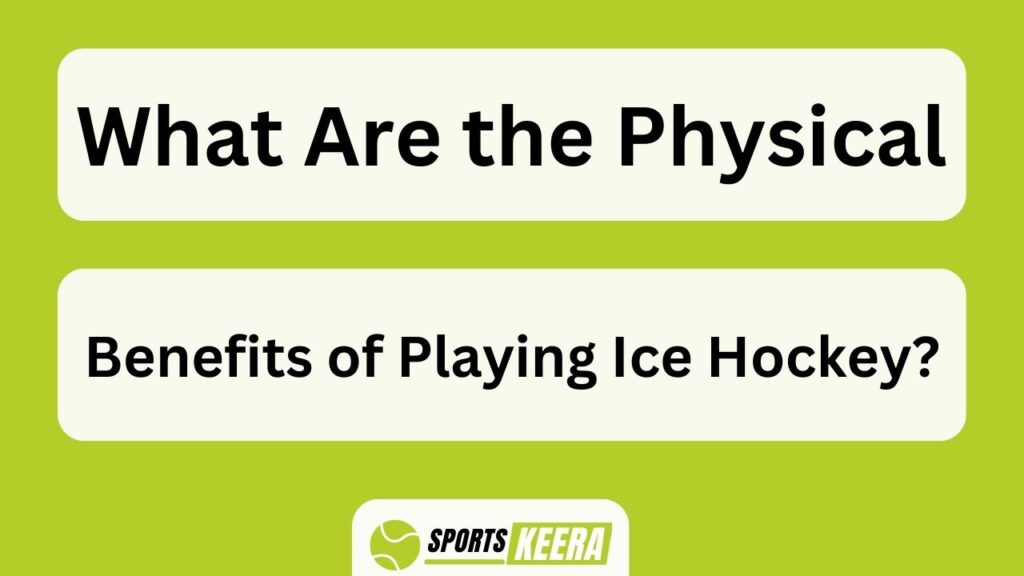Playing ice hockey is like gliding on a frozen river of physical benefits. As the players gracefully navigate the icy rink, they are not only showcasing their skills but also reaping numerous advantages for their bodies.
From a full-body workout that engages every muscle group to cardiovascular fitness that gets the heart pumping, ice hockey offers a comprehensive exercise experience. With strength and power training at its core, this sport builds lean muscle mass and enhances overall athleticism.
The fast-paced nature of the game improves agility, balance, coordination, and reflexes – essential skills for any athlete. Moreover, engaging in ice hockey provides mental and cognitive benefits such as improved focus, decision-making abilities, and strategic thinking. It also acts as a stress reliever and mood enhancer due to the release of endorphins during intense gameplay.
Additionally, being part of a team fosters teamwork skills and social interaction. Lastly, it aids in injury prevention and rehabilitation by promoting joint stability and strengthening muscles around vulnerable areas.
Overall, playing ice hockey is not just about scoring goals; it’s about elevating one’s physical well-being on multiple levels.
Key Takeaways What Are The Physical Benefits Of Playing Ice Hockey?
- Comprehensive exercise experience engaging every muscle group and improving cardiovascular fitness.
- Builds lean muscle mass and enhances overall athleticism.
- Fast-paced nature of the game improves agility, balance, coordination, and reflexes.
- Aids in injury prevention and rehabilitation by promoting joint stability and strengthening muscles.
Full-Body Workout
You’ll love how playing ice hockey gives you a full-body workout, toning your muscles, improving your cardiovascular health, and boosting your overall strength and endurance.
Ice hockey requires the use of multiple muscle groups throughout the body, making it an excellent sport for building core strength. Skating alone engages the lower body muscles, including the quadriceps, hamstrings, and glutes. The constant movement on the ice also works out the upper body muscles like biceps, triceps, and shoulders as players handle sticks and shoot pucks. Additionally, ice hockey is a high-intensity activity that burns calories rapidly. On average, players can burn around 500-700 calories per hour while playing. This combination of muscle engagement and calorie burn makes ice hockey an effective way to achieve a toned physique while enjoying an exhilarating game on the ice.
As players engage in this intense physical activity, their cardiovascular fitness levels also improve significantly. The fast-paced nature of ice hockey forces players to constantly move across the rink at high speeds. This continuous movement elevates heart rate and increases oxygen intake, leading to improved cardiovascular endurance over time. Research has shown that regular participation in ice hockey can lead to decreased resting heart rate and increased lung capacity. These cardiovascular benefits not only enhance overall athletic performance but also contribute to long-term heart health.
Transitioning into discussing cardiovascular fitness without using ‘step’, one important aspect of playing ice hockey is its impact on overall cardiovascular health…
Cardiovascular Fitness
Experience an exhilarating rush and increase your overall endurance by engaging in this fast-paced sport on the ice. Ice hockey is not only a thrilling game, but it also offers numerous physical benefits.
One of the key advantages of playing ice hockey is improved endurance and heart health. The constant movement on the ice requires players to maintain a high level of cardiovascular fitness throughout the game. Skating, shooting, and passing all contribute to an elevated heart rate, which strengthens the heart muscle and improves its efficiency. Regular participation in ice hockey can lead to increased stamina and better overall cardiovascular health.
Transitioning into the subsequent section about strength and power training, ice hockey’s demanding nature requires players to possess both strength and power.
Strength and Power Training
Improve your performance on the ice by incorporating strength and power training into your routine, as studies have shown that athletes who engage in regular strength training exercises experience a 20% increase in shot power. Off-ice training plays a crucial role in developing the muscles required for ice hockey. By focusing on muscle development through targeted exercises, players can enhance their overall strength and power, leading to improved performance on the ice.
To understand the specific benefits of strength and power training for ice hockey, let’s take a closer look at a three-column table:
| Benefit | Explanation | Example Exercise |
|---|---|---|
| Increased Shot Power | Strengthening key muscles like the core and legs allows players to generate more force behind their shots | Squats, deadlifts |
| Enhanced Speed | Building explosive power in the lower body helps players accelerate quickly during sprints and maneuver on the ice | Plyometric exercises |
| Improved Stability and Balance | Developing core stability improves balance while executing quick turns or maintaining control during physical play | Planks, Russian twists |
Incorporating these off-ice training techniques not only enhances shot power but also improves agility and balance on the ice.
Improved Agility and Balance
Enhancing your agility and balance is essential for dominating the game and outmaneuvering opponents on the rink. Ice hockey requires players to move quickly, change direction rapidly, and maintain stability while performing various skills.
Through regular ice hockey training, players can improve their speed and quickness, allowing them to react swiftly to the fast-paced nature of the game. Additionally, practicing injury prevention techniques such as balance exercises can help reduce the risk of falls and collisions on the ice.
Improved agility not only benefits a player’s performance but also reduces the likelihood of injuries. By enhancing their balance, players can maintain control over their bodies during challenging maneuvers, minimizing the risk of sprains or fractures.
Improved agility and balance go hand in hand with enhanced coordination and reflexes, which will be discussed in detail in the subsequent section.
Enhanced Coordination and Reflexes
With enhanced coordination and lightning-fast reflexes, players become the maestros of the rink, effortlessly orchestrating their every move. Ice hockey requires players to constantly adjust their body position, make split-second decisions, and react quickly to unpredictable situations. As a result, playing ice hockey leads to improved hand-eye coordination and increased reaction time.
The fast-paced nature of the game forces players to develop exceptional coordination skills. Skating while controlling the puck and evading opponents requires precise control over both hands and feet. This improves not only hand-eye coordination but also overall body coordination.
Additionally, ice hockey demands lightning-fast reflexes. Players must anticipate where the puck will be and react instantaneously to steal it or make a pass. The constant need for quick decision-making enhances their reaction time in other areas of life as well.
Transitioning into discussing increased flexibility…
Increased Flexibility
Playing ice hockey can lead to players becoming more flexible and agile on the rink. The fast-paced nature of the game requires quick movements, changes in direction, and sudden stops, which all contribute to improved mobility. Flexibility is a key component in preventing injuries as it allows players to move through a greater range of motion without straining muscles or joints.
Regularly participating in hockey helps increase flexibility by stretching muscles and tendons, making them more elastic and less prone to injury. Additionally, the dynamic nature of the sport requires players to constantly adapt their body positions, further enhancing their overall agility. These physical benefits not only improve performance on the ice but also carry over into everyday life activities.
Transitioning into mental and cognitive benefits, ice hockey also offers various advantages for players’ minds.
Mental and Cognitive Benefits
Improve your mental agility and cognitive skills by engaging in the exhilarating sport of ice hockey. Ice hockey not only offers physical benefits but also provides numerous mental and cognitive advantages.
Research suggests that participating in ice hockey can enhance mental clarity and improve cognitive function. The fast-paced nature of the game requires players to make split-second decisions, boosting their concentration, problem-solving abilities, and decision-making skills. Additionally, ice hockey involves strategic thinking, as players need to anticipate movements and coordinate with their teammates effectively. These aspects of the game help sharpen mental acuity and promote quick thinking under pressure.
By challenging the mind in various ways, playing ice hockey can contribute to overall cognitive development. Transitioning to stress relief and mood enhancement, another significant benefit of this dynamic sport is its ability to uplift spirits while providing a sense of relaxation and enjoyment.
Stress Relief and Mood Enhancement
Ice hockey not only offers mental benefits but also provides significant physical advantages. In addition to improving cardiovascular fitness, playing ice hockey can be an excellent way to manage stress and enhance mood. Engaging in physical activity, such as ice hockey, has been shown to reduce stress levels by releasing endorphins and promoting a sense of well-being. It can serve as a healthy outlet for pent-up emotions and frustrations, allowing players to clear their minds and find relief from daily pressures. Furthermore, the adrenaline rush experienced during gameplay can boost mood and energy levels. To visually illustrate the positive impact of ice hockey on stress management and emotional well-being, consider this table:
| Physical Benefits of Playing Ice Hockey |
|---|
| Improved cardiovascular fitness |
| Stress reduction |
| Mood enhancement |
| Emotional well-being |
Moving forward into the next section on teamwork and social interaction…
Teamwork and Social Interaction
Engaging in this sport fosters a strong sense of camaraderie and meaningful connections with teammates. Ice hockey is not just about individual skills and performance; it requires effective communication between players on the ice. This constant need for clear and concise communication improves players’ verbal and non-verbal communication skills, allowing them to react quickly to changing game situations.
In addition to communication skills, ice hockey also promotes conflict resolution abilities. With the fast-paced nature of the game, disagreements and conflicts are bound to arise among teammates. Resolving these issues in a constructive manner is crucial for maintaining team cohesion and harmony.
The benefits of teamwork and social interaction extend beyond the rink. Players learn how to work together towards a common goal, trust their teammates, and depend on each other’s strengths. These skills are transferable to various aspects of life, such as school or work environments.
Transitioning into injury prevention and rehabilitation: Understanding the importance of teamwork helps players prioritize safety on the ice, preventing injuries that could impede their athletic journey.
Injury Prevention and Rehabilitation
Take care of your body and prioritize injury prevention and rehabilitation to ensure you can continue participating in the sport you love. As the saying goes, ‘An ounce of prevention is worth a pound of cure.’
When it comes to ice hockey, understanding injury prevention techniques and implementing them into your training routine is crucial. Strengthening muscles through conditioning exercises, such as squats and lunges, can help improve stability and reduce the risk of common injuries like sprains or strains. Additionally, wearing protective gear, such as helmets and padding, can provide an added layer of protection during gameplay.
However, accidents can still happen despite precautions taken. In these cases, post-injury recovery strategies become essential for getting back on the ice as soon as possible. Seek medical attention promptly if injured and follow proper rehabilitation protocols recommended by healthcare professionals to ensure a safe return to play.
Frequently Asked Questions
How long does it take to see physical benefits from playing ice hockey?
It typically takes several months of regular ice hockey practice to see long-term physical benefits, such as improved muscle strength. Engaging in this sport can help build and tone muscles throughout the body.
Can playing ice hockey help with weight loss?
Playing ice hockey can help with weight loss due to its high-intensity nature and the significant caloric burn it provides. The fast-paced game promotes cardiovascular fitness, muscle strength, and endurance, making it an effective workout for shedding pounds.
Are there any age restrictions for playing ice hockey?
Age restrictions for playing ice hockey vary depending on the league or organization. Safety guidelines are put in place to protect players of all ages, ensuring that they can enjoy the sport in a safe and controlled environment.
Is it necessary to have previous skating experience to play ice hockey?
Skating skills are essential for playing ice hockey, but previous experience is not always necessary. With the right equipment and training, anyone can learn to play.
Can playing ice hockey improve bone density?
Playing ice hockey can improve bone density due to the high impact nature of the sport. In addition, it also improves cardiovascular health and enhances coordination and balance, making it a great overall workout.
Conclusion
In conclusion, the physical benefits of playing ice hockey are truly remarkable. With its combination of a full-body workout, cardiovascular fitness, strength and power training, improved agility and balance, enhanced coordination and reflexes, mental and cognitive benefits, stress relief and mood enhancement, teamwork and social interaction, as well as injury prevention and rehabilitation; it’s no wonder that ice hockey is considered one of the most physically demanding sports out there.
So, lace up those skates and get ready to experience a thrilling journey towards optimal health and wellness on the ice!





